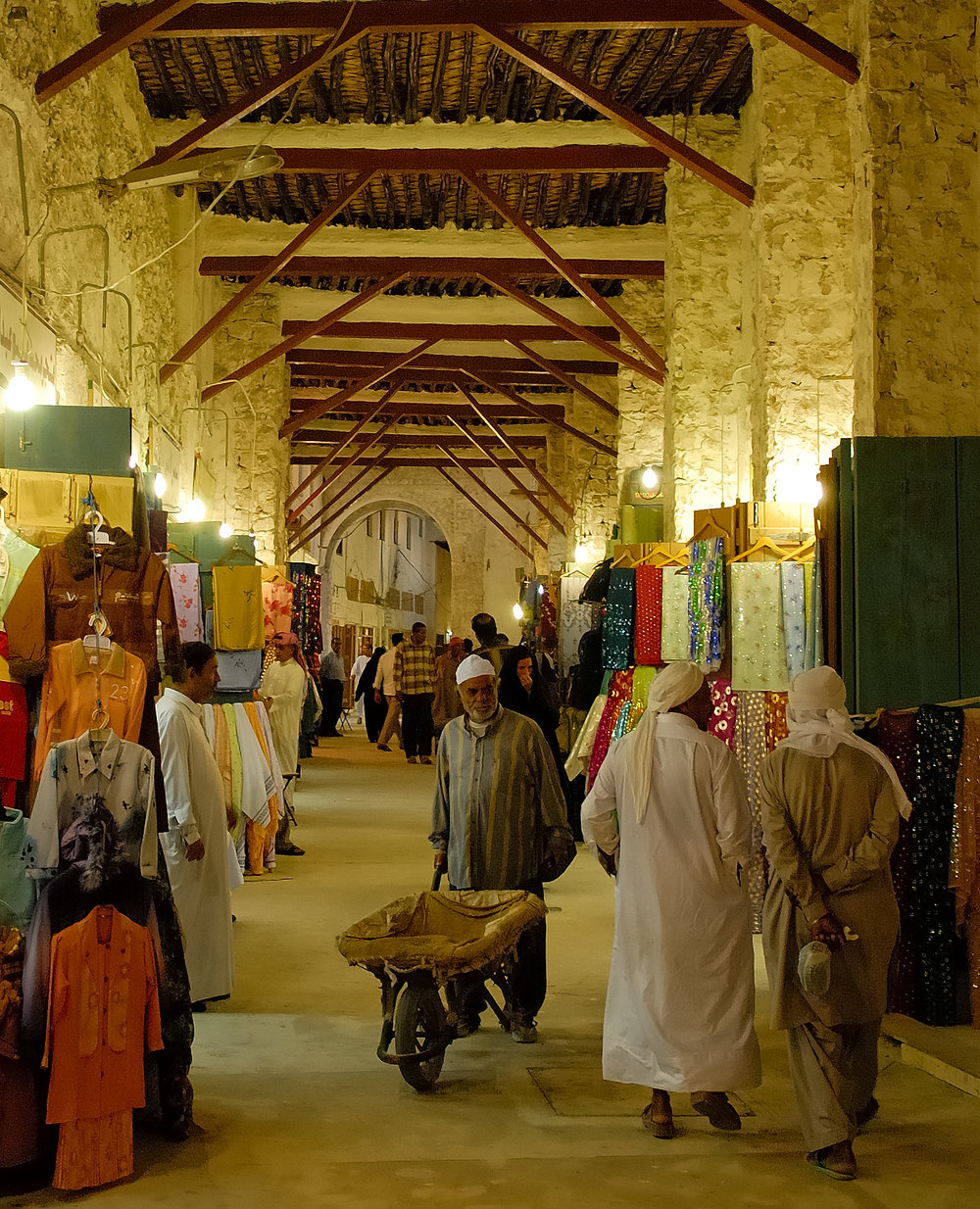
In 2005 I was invited to Qatar and was asked if I would head up the liberalisation of the telecoms market. Even though I am not a great fan of very warm weather, I accepted the challenge and thus I spent about five years doing that task in Qatar.
I visited other countries in the region while I was working in Qatar and I intend to do a series of articles for Macfilos showing the photos I still have from those countries, as well as Qatar itself. Some photos have gone missing for various reasons. This is a ‘taster’ for those articles, set out in the sequence of our visits with a couple of photos from each location. The articles will appear in the same sequence.
Qatar
The photo at the top of this article was taken in a souq in my first week in Qatar. Try as I might, I could never get one as good as this in the souq again. I feel that I must have lost my sense of wonder as what had seemed exotic at first became commonplace. I call this one ‘The Barrowman of Souq Waqif’. The barrowman brings items, bought in the souq, to your car for a small fee. When he is not doing that, he sits in the barrow relaxing on the soft sack lining. This photo contains so many different elements that it summarises the Middle East for me.
Qatar is a small country, but is also one of the wealthiest nations on the planet. It has many towering skyscrapers, but you cannot avoid the Gulf and the desert while you are there.
An essential trip is to go into the Gulf on a traditional Arab dhow, particularly in the evening when the sun is starting to go down
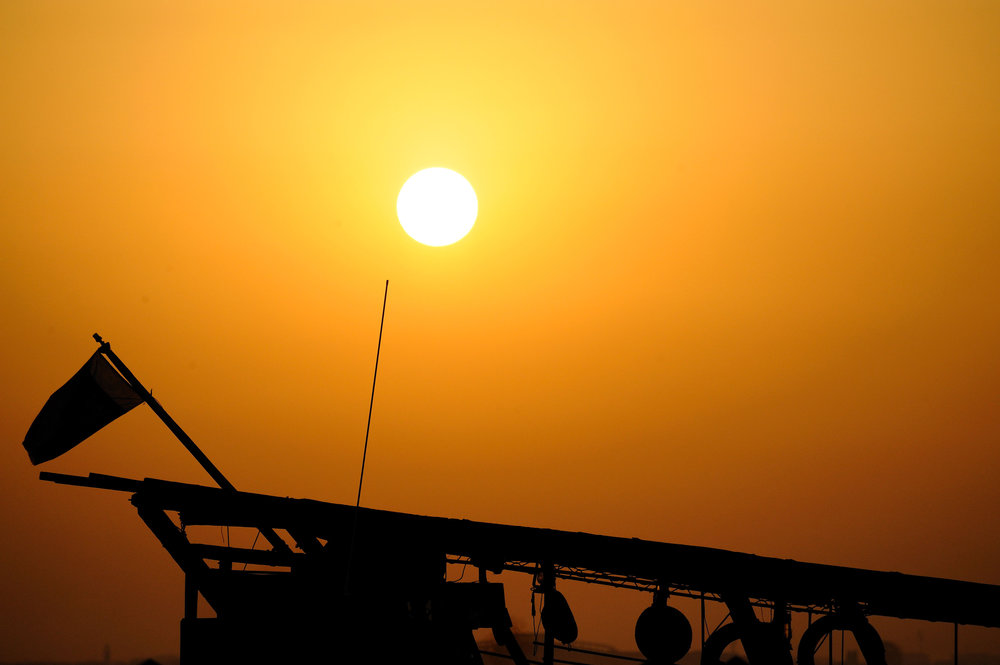
Trips into the desert do not take that long, as most of the country is desert. The Bedouin often allow their camels to roam around. I came across this one on a trip to the desert with a South African friend. I was not able to drive at the time as I was recovering from an eye operation, but I was in the front passenger seat as my South African friend drove off the road around this fellow who would not move. He and his kind had been there long before cars and jeeps, of course. That is why I call this photo ‘Timeless’.
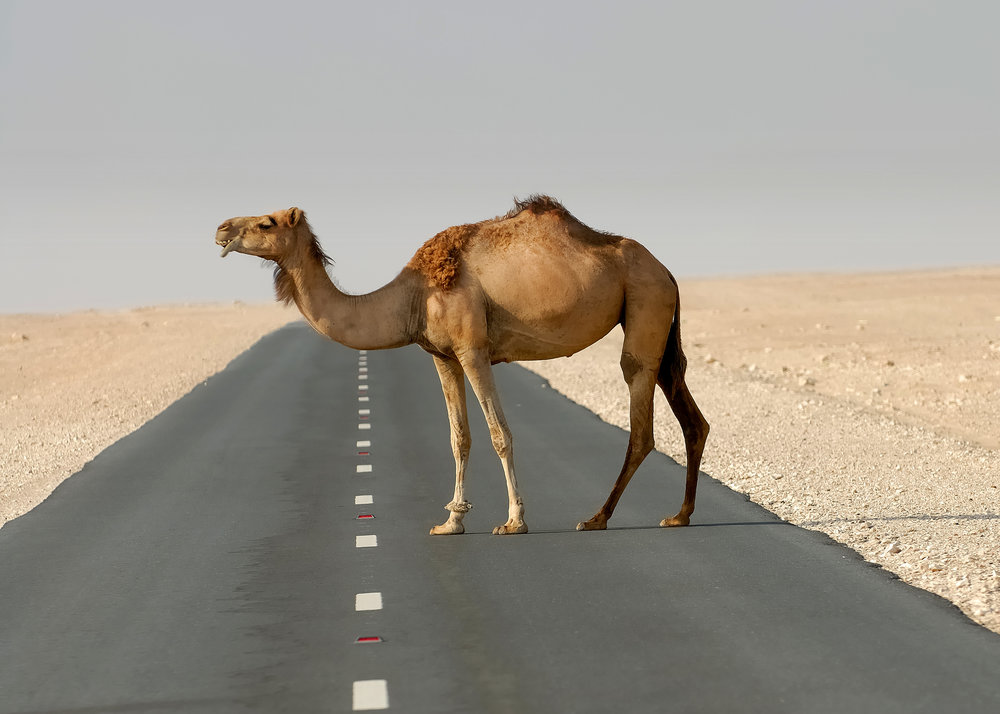
Oman
The first country that we visited from Qatar was Oman. Oman is a much larger country than Qatar and it has spectacular mountains as well as deserts and even some green areas, but the population density is quite low. The Omani people are very friendly and their culture is quite different in a number of respects to that of other nations in the region. There are people in Oman who can trace their roots back to Africa. If I were asked to name one country in the region to visit, Oman would be my first choice.
This chap was our driver in Oman. His name is Essa (can also be Issa), pronounced ‘E-sah’, which translates as ‘Jesus’. Interestingly, Iosa is the word in the Irish language for ‘Jesus’, pronounced more or less the same way.
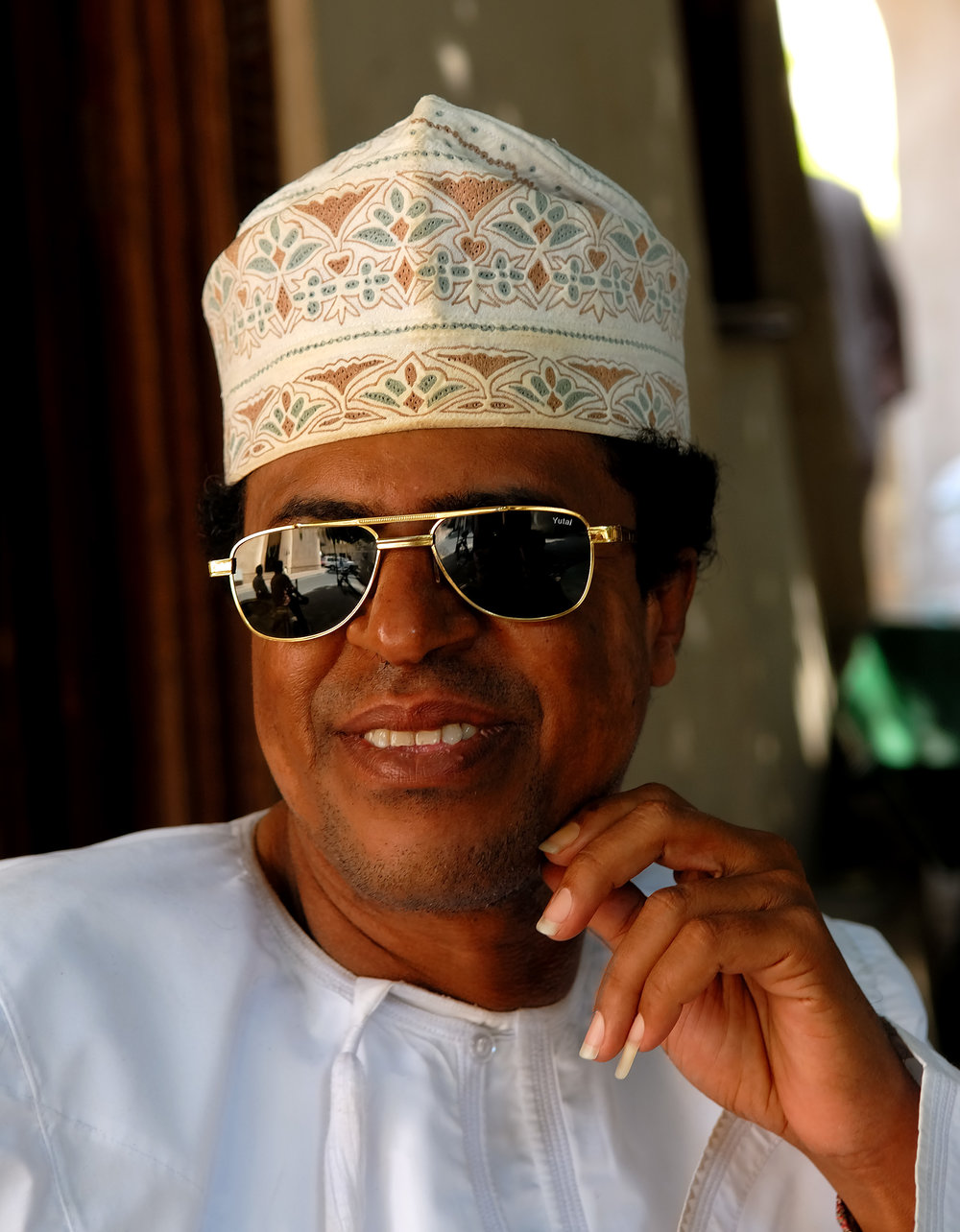
The coast of Oman is spectacular and we took a boat trip on which we saw many sights like this.
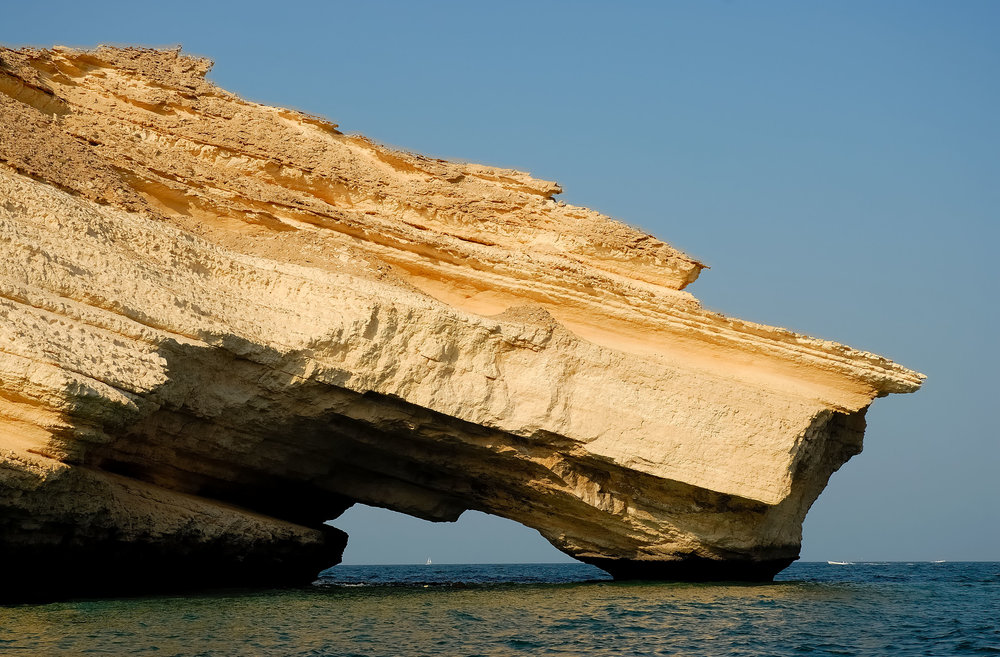
I visited the United Arab Emirates and Bahrain on a number of occasions, largely for business reasons, but also for leisure, such as two trips to the Grand Prix in Bahrain. The countries are similar in many ways to Qatar and are quite familiar to many people in Europe and elsewhere, so I won’t do an article on either country.
Jordan
We visited Jordan with a group from the Qatar Natural History Group. We travelled around quite a bit from Gadara (now Umm Qais) in the north, near to the Golan Heights, to Wadi Rum in the south.
Jordan is like Syria in appearance, but it seems to have escaped the internal difficulties and differences that have affected its neighbour. It is not nearly as wealthy as any of the Gulf States.
The two highlights in Jordan, for me, were Petra and Wadi Rum. This is the classic view of the Treasury in Petra taken from the long narrow passageway or canyon called the Siq.
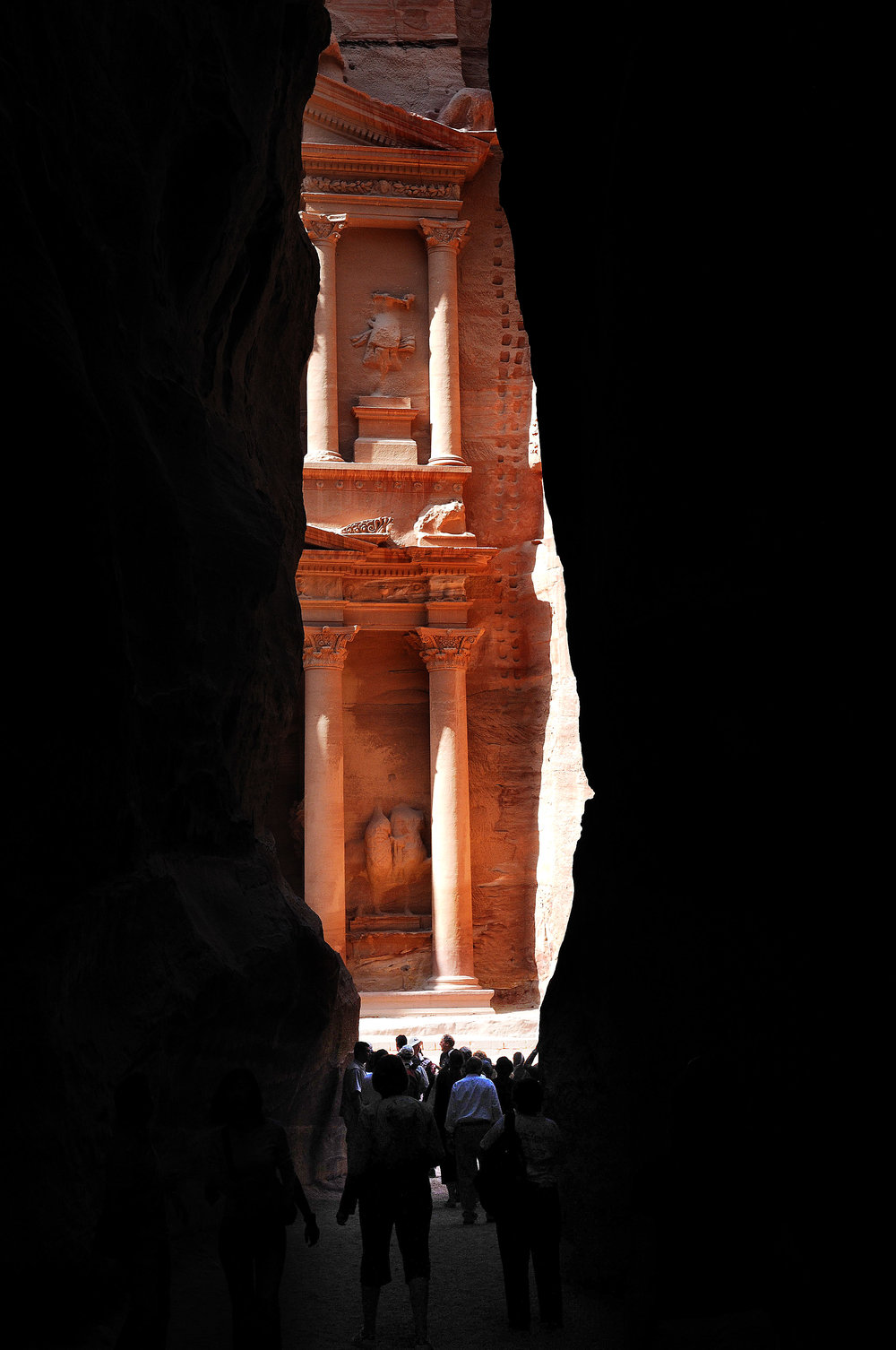
There was a lot more to Petra than the Treasury and the Siq. The Nabataeans, who built the place, are gone now, but the Bedouin are still there. I will try to show a broader perspective in my article.
This photo is from Wadi Rum. If it were not for the clothing of the tourists, this could have been recorded any time in the past few centuries. The location will, of course, be familiar to anyone who has seen the film Lawrence of Arabia.
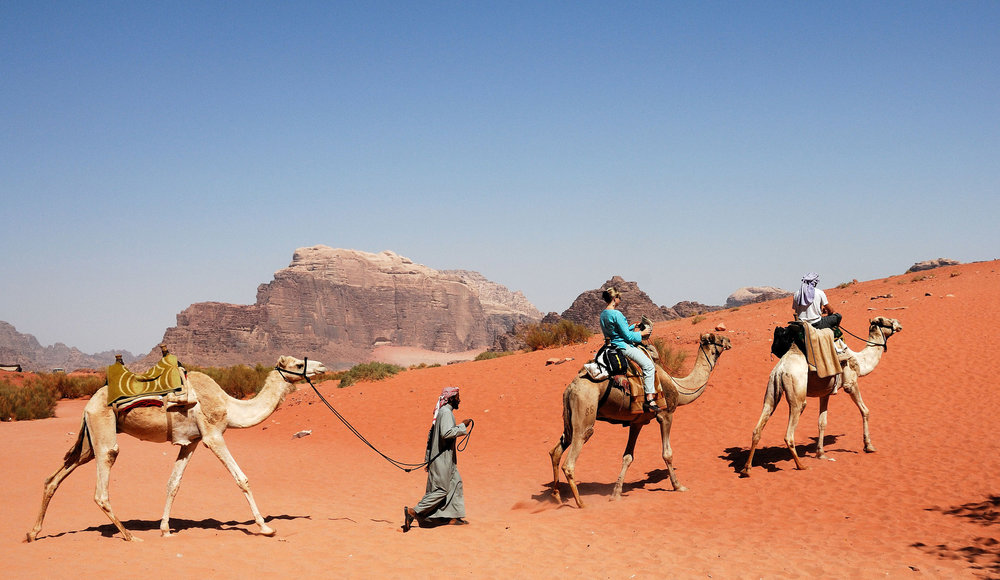
And, yes, the sand really is that colour. I will provide other examples in the article.
Turkey
Our next trip was to Turkey, which is in the broader Middle East region. It is an Islamic country and when we arrived Ramazan (the Turkish version of Ramadan) had ended and the souq had closed for Eid. This did not bother us too much as we had been in plenty of souqs in our time in the Middle East.
Some of my Turkey photos have gone missing, probably due to the theft of a laptop while returning from Qatar, but I have enough for an article.
This is the interior of the Hagia Sophia in Istanbul, which changed hands between Christianity and Islam and contains symbols of both religions. It is now a secular museum.
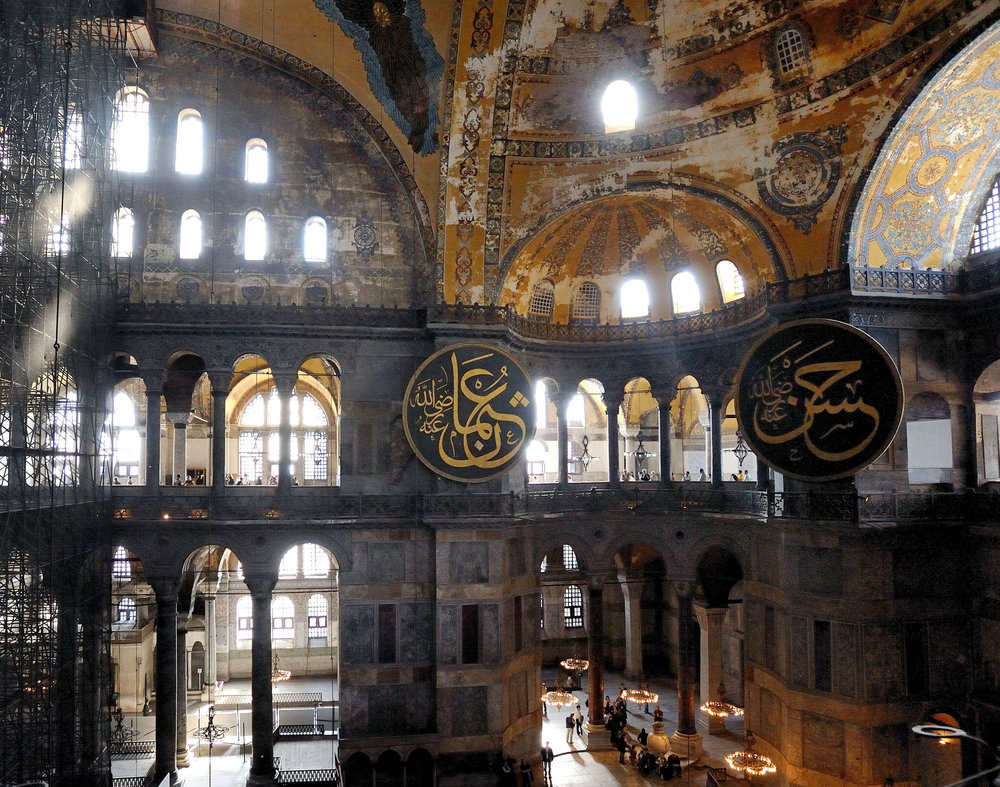
Insert Photo 8
At the other end of the scale, here is the entrance to the Sultan’s Harem in the Topkapi Palace.
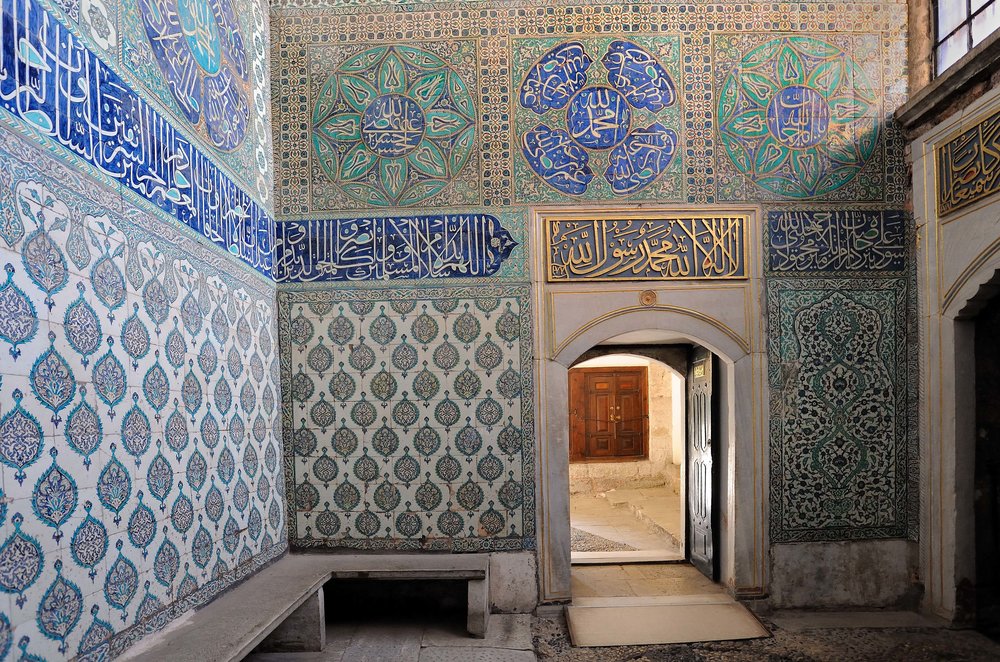
I also went on business trips from Qatar to Thailand and Hong Kong and took a few days to look around in both countries, but they do not represent a good fit with the Middle East. A trip which we took to India, to travel on the Palace on Wheels train in Rajasthan, seems to be a good fit, though.
India
Our train journey started and finished in Delhi. It took in Jaipur, Udaipur, Jaisalmer, Chittorgarh, Ranthambore National Park, Agra (Taj Mahal) and Jodhpur. I knew a lot of Indian people in Doha and some of them were on my team. The country was a real eye opener, however, and we saw things there that we could not imagine before we went. India is a country (a sub-continent) that gives rise to a whole range of emotions.
Here are just two photos, which do not go near capturing what we saw.
Firstly, here is one of the Monkeys that had a free run on a sacred site in Chittorgarh. Their main sport was grabbing the garlands of flowers around the necks of visitors and eating them (the flowers and not the visitors). This one is having a feed of flowers while watching the setting sun.
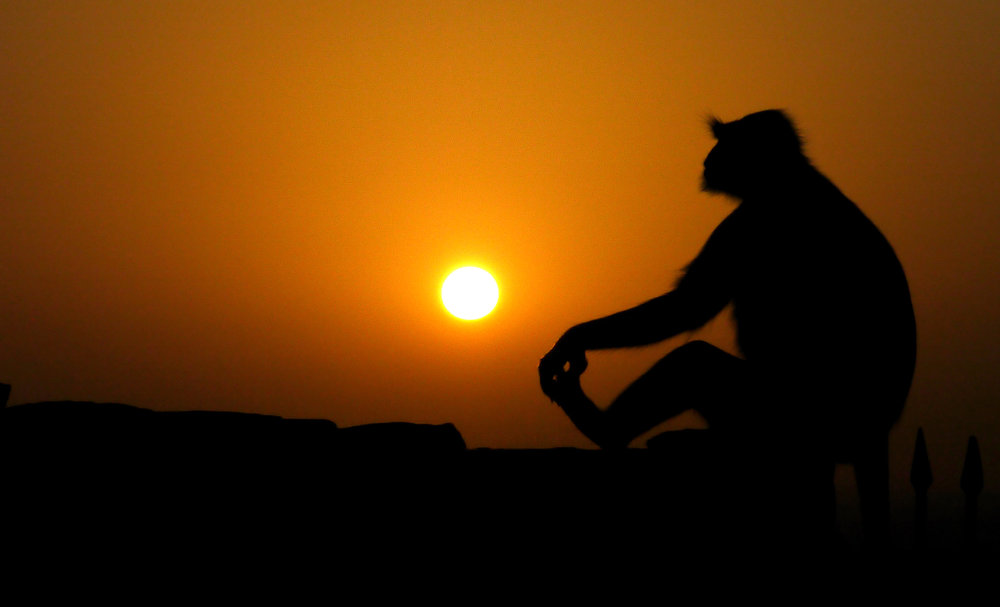
The ruling class in India lived in great style in times past and the rajahs and their families were carried around on various devices, such as this palanquin, seen at the Mehrangarh Fort in Jodhpur
Syria
Our final Middle East trip was to Syria and this was already the subject of this article on Macfilos
Here are two photos from that trip to complete the picture, as it were.
Palmyra
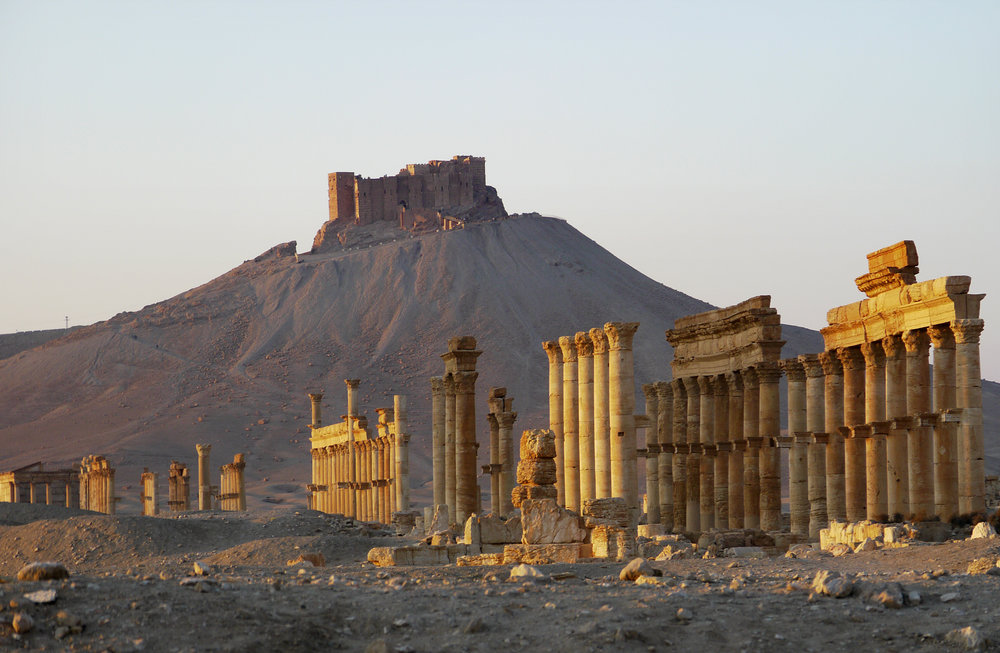
Aleppo
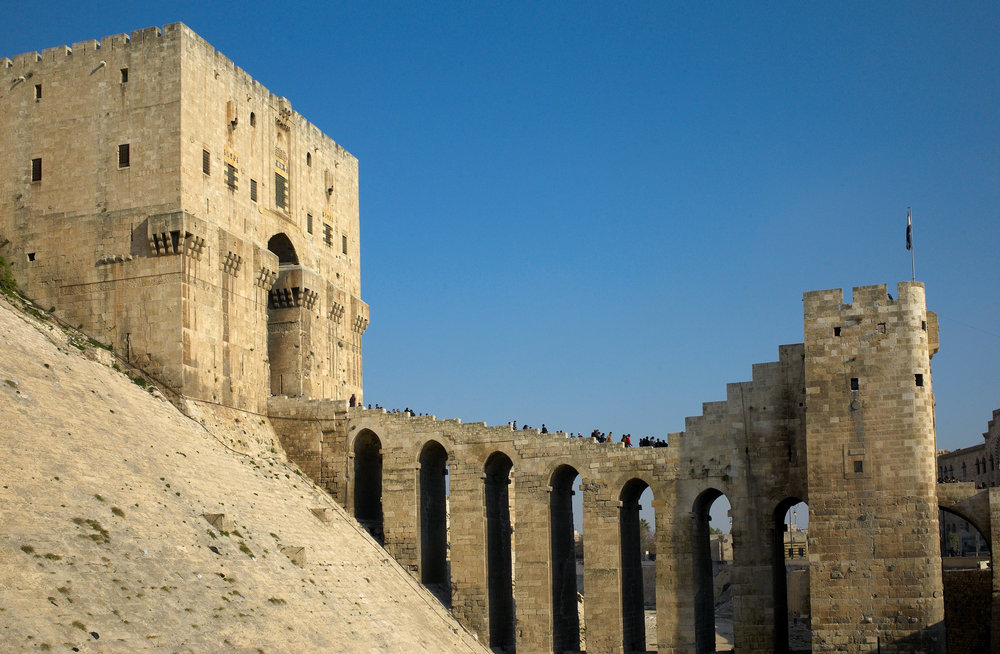
Other countries that I wanted to visit in the region included Iran and Egypt, but we did not visit them for various reasons, mainly internal issues. We had really wanted to visit Iran in 2009, but riots broke out after an election, so we went to Syria instead.
The war in Iraq was ongoing while we were in Qatar and US fighter jets flew over our apartment every night at about the same time on night missions to Iraq. For us, Kuwait seemed to be too close to Iraq. I got many invites to Saudi Arabia, but, even though my opposite numbers in Saudi were most charming people, I did not have a real enthusiasm to go there, so I usually asked a Qatari member of staff to go on my behalf.
Finally, even before the war, Yemen seemed very remote, even from Qatar. A friend of mine has thousands of slides, which he took in Yemen about 40 years ago. They show a country, which is quite different to any other part of the Middle East. We keep talking about doing a big scanning exercise on the slides.
The cameras used for the photos in the articles were many and varied and included the Nikon D200, D2Xs, D3, D700, Fujifilm F10, Lumix LX3, G1, GH1 and the Leica M8. I won’t be making any comparisons. For me, the best camera is always the one you have with you.
______________

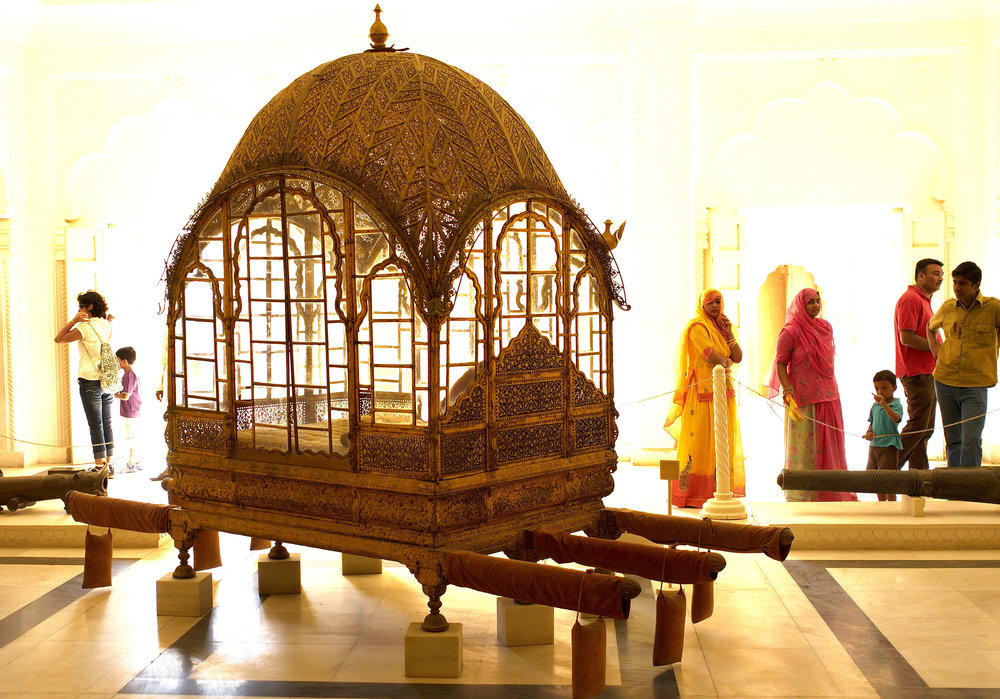
Fabulous photos William and what a range of subjects! Portraits, landscapes, street photography, all very well done. This is one part of the world where I have not traveled and I am really looking forward to seeing more.
Thanks Richard. I would recommend Oman and Jordan to start with. You could spend the rest of your life travelling around India, but the Rajasthan train is well worth travelling on and I believe that it has been modernised since we were there 9 years ago.
William
William, such wonderful images! My wife and her friend still talk about the wonderful show and talk you gave here in Chicago on Syria. We are going on a 13 day Med cruise this fall, and I look forward to getting some results as wonderful as yours. I will follow your advice by using online resources to do some advance leg work. I also rely on my history minor background for having a basic understanding of the history of the areas I visit. It helps to understand the history of the people and the areas to know what you are seeing. Pretty basic, but I imagine most people are too lazy to do this.
I always like to think that when the people of the area tire of the political and religious BS that has ruined their lives, when you can’t even expect to raise a normal family, that is when things will change. I believe that most people only want a decent life with their family and a little peace in their life. Life is just too short. Perhaps this is naive, but one has to hope in the basic decency of humanity despite the horrible things we see on a daily basis. As the old saying goes, "Leben und las leben".
Thanks Bill. I look forward to seeing you again in Wetzlar next October. I suspect you will visit Venice on your Med trip. It is one of those ‘must see’ places. I have been in Venice in 1984 and 2005 and there was a huge increase in the number of visitors between those two dates. Getting into Venice and other Mediterranean destinations early in the morning is key to getting good shots. Nowadays we have Wikipedia, Google Earth/Maps and Street View to help plan a day’s shooting, but I find that the ‘look around’ and ‘look behind’ techniques are equally important to add to the planned shots.
As for the issues in the Middle East, they will only be solved by the people who live in the region. Differences are many and are based on religion, tribalism, factionism and economic rivalries. The people, when you meet them, are all good kind people and while I worked in the Middle East I had people from 6 different continents on my team, including many from Qatar and neighbouring countries, and we all got on with one another and got the job done.
William
Hi William, Thank you for sharing these images, the story behind them, and more importantly the experience of shooting in what must have felt like the most unique landscape available. I look forward to future articles and images. Dave
Thanks Dave. I am looking forward to doing the articles. I have visited a lot of other places, but these ones seem to have a theme or thread running through them, which will, hopefully, work as a series.
William
Thanks William, the picture in the souk is very evocative and takes me back to a place I also know well. Regarding your description of having ‘eyes wide open’ I think there are parallels between the way a camera and I see things. When I go to a new place my eyes are wide open and I take in many things at once but, as with a wide aperture, not in depth. Once I settle and metaphorically the aperture of my eyes returns to normal I see things in depth. I’m looking forward to reading more of your articles!
Thanks Kevin. They say that the camera sees what the photographer sees, but as you walk around you will always see things that you did not expect. One rule I always apply is to look around from any scene. They say that you always leave the best shots behind you. I recall one time taking a photo of a cathedral in Siena in Italy and then looking around to see an even better shot of the cathedral reflected in a window behind me. I took that shot and then went over to join my wife sitting on the front steps of the cathedral. We then watched as another guy with a camera, who had seen me, did the same thing and then another person imitated him and so on. I am also a tour guide’s worst nightmare as I listen with one ear and look around for photographic opportunities at the same time. Nowadays Wikipedia and Google maps are great assets and I always think through potential shots before I visit any location, but I am always delighted to be surprised with something I did not expect.
William
So beautiful the closest I came was Ethiopia and Eqypt, back when Haile Selassie ruled the roost, he never traveled Asmara without an Army convoy, when he traveled the Army locked the area down. Just a fantastic journey you took us on, thank you!
Thanks John. I will show in my article on Oman how in the sea between Arabia and Africa, British influences still remain. All will be revealed in time.
William
A fascinating article and some evocative images William. How sad to think that those wonderful sites in Palmyra and Aleppo are now lost.
I’m looking forward to the next edition of your saga.
Thanks Mike. The solutions to the conflicts in the Middle East have been sought for a long time. The people I met in the region were all very friendly towards those from outside the region. The real solutions lie in the people in the region getting together to create something lasting from an economic and social perspective. People who are focussed on work and economic development do not have the time for such conflicts. Palmyra and Aleppo contain some of the oldest and most extensive ancient structures on our planet. Their continued survival depends on those who live in those places, but just know their focus is on survival rather than development and conservation.
William
Very interesting, William and super photos. It is amazing, yet true, familiarity sets in extremely quickly. Looking forward to seeing the rest of your series.
Thanks David. While some things became familiar, the Middle East never lost its capacity to surprise. It is not an area where monoculture applies and many differences can be seen between the different countries. India was the biggest eye opener and, of course, and, while it is not part of the Middle East, it has nearly 190 million Islamic people making it the country with the third largest Islamic population in the world after Indonesia and Pakistan. Even on our last trip, to Syria, we saw things that surprised, but we were able to look at the country with eyes that had become attuned to the region.
William
Yes Souq Barrowman a great image to start the journey. And the wild light in the Hagia Sophia Istanbul pic provides a great counterpoint to the darker interior.
Thanks Wayne. The Hagia Sophia was undergoing renovation and there was a lot of scaffolding about. I went up onto the balcony there in an attempt to capture both Christian and Islamic symbolism. Istanbul is a true East meets West place and this has been the case for a lot of its history.
William
Outstanding, William. The Souq Barrowman is a cracking photo, great lighting and tone. Looking forward to the articles.
Thanks Jason. This was taken on my first visit to the souq almost exactly 12 years ago with a very new Nikon D200 and 17-55mm f2.8 zoom. It was shot at 19mm, 1/60th, f4 and at what was then an astounding ISO 640. I processed the image afterwards with Nikon Capture and Photoshop Elements which were pretty primitive by comparison with the Lightroom of today. I had heard that taking photos of people in public places could be regarded as ‘haram’, so I did not dare get up close to the barrowman. I was also trying to capture the wonderful ceiling details in the souq. My younger daughter had a canvas backed version of this made for me at 20×16 inches. It hangs proudly in our conservatory and has not faded at all.
As I mentioned in the article, I was shooting with the wide open eyes of a visitor to an exotic place and I could never capture that feeling again when visits to the souq became commonplace. The elements in the picture include not only the barrowman and the ceiling, but also the building and the lighting and the people in a mixture of Arabic and Western clothing. It also has features such as the articles on sale in the souq and little details like the woman behind the barrowman looking at a piece of cloth. I can almost smell the ‘oud’ wood incense and the spices on sale in the souq every time I look at this photo. Sometimes you have to wait a long time before you get a photo that encapsulates a place, but, in this case, I got one very early in my stay.
William